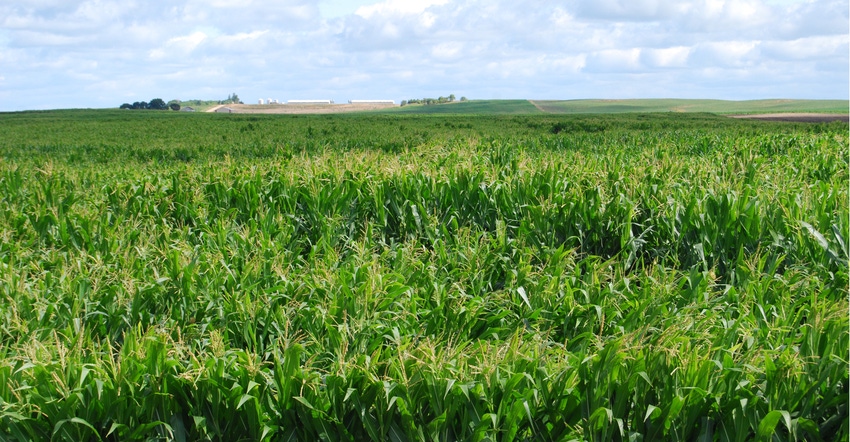
The official 2016-17 average national commodity prices and the 2016 county yields used in the calculation of USDA farm program payments were released Oct. 4 by the Farm Service Agency. The average corn and soybean prices are $3.36 and $9.47 per bushel, respectively.
Related: ARC payments shrink for corn and soybeans
Some farmers can expect to begin receiving Agriculture Risk Coverage (ARC) and Price Loss Coverage (PLC) payments from FSA during the next few weeks. On average, ARC-County or ARC-CO payments (revenue loss coverage at the county level) in Iowa per corn and soybean base acres will amount to $12.47 and 41 cents, respectively. And it will represent only 37% and 3% of the payments received in 2016, according to Iowa State University Extension economists.
Use online tool for county’s standing
The geographical distribution of the payments can be visualized online using the ISU Center for Ag and Rural Development’s decision tool at ARC/PLC Payments per Base Acre in Iowa.
“This tool will let farmers know whether they can expect to receive an ARC-CO or PLC payment in the coming weeks, and how much they can expect,” says Alejandro Plastina, ISU assistant professor and Extension economist. “This information should aid them in developing a marketing strategy to cover their short-term cash flow needs while targeting a profit for their 2017 crop.”
ARC-CO payments for corn base acres will be distributed among farmers in 59 Iowa counties, while payments for soybean base acres will be distributed in five counties, Plastina notes.
Higher yields in 2016 mean lower ARC-CO payments
Although crop prices were lower in 2016-17 than in 2015-16, corn and soybean yields were, on average, 13.2 and 4.4 bushels higher. Higher yields in 2016 resulted in lower ARC-CO payment rates. Only 13 counties realized lower corn yields in 2016-17 than in the previous year, and only five counties had lower soybean yields.
All corn base acres enrolled in PLC will receive a payment ranging from $26.40 to $48.47, and averaging $39.27 for the state of Iowa. "Less than 2% of all program base acres are enrolled in PLC in Iowa,” says Plastina. “This will be the first time since the inception of the 2014 Farm Bill that PLC payments will be larger than ARC-CO payments in all Iowa counties except for Grundy, Johnson and Mills.”
Soybean base acres enrolled in PLC will not receive a payment in 2017, just like in the previous two years.
Comparing payments, programs last 3 years
Comparing payments across programs over the last three years, Plastina says it is interesting to note:
• All Iowa counties have received ARC-CO payments on corn base acres at least once, except the following 13 counties: Appanoose, Clarke, Decatur, Henry, Jefferson, Keokuk, Lucas, Monroe, Ringgold, Van Buren, Warren, Washington and Wayne.
• All Iowa counties have received ARC-CO payments on soybean base acres at least once, except the following 14 counties: Adair, Appanoose, Calhoun, Carroll, Cerro Gordo, Davis, Guthrie, Henry, Lucas, Madison, Mitchell, Monroe, Sac and Worth.
• All Iowa counties have received some ARC-CO payment except Appanoose, Henry, Lucas and Monroe.
• For most counties, the cumulative ARC-CO payments for corn base acres are larger than the cumulative PLC payments for corn base acres, except for the following 26 counties: Appanoose, Calhoun, Clarke, Dallas, Davis, Decatur, Des Moines, Guthrie, Henry, Jasper, Jefferson, Keokuk, Lee, Lucas, Madison, Mahaska, Marion, Monroe, Polk, Ringgold, Union, Van Buren, Wapello, Warren, Washington and Wayne.
Harder to cash-flow farm operations
“In times of low commodity prices and thin profit margins, cash-flowing farm operations becomes increasingly challenging,” says Plastina.
According to a recent ISU Extension and Outreach report, a substantial share of Iowa farms have vulnerable liquidity positions, and solid financial planning will prove critical for success of farm operations. The report also lists the resources available to Iowa farmers to help them navigate the planning process and cope with stress. The publication, titled Financial stress in Iowa farms: 2014-2016 is available through ISU Extension Store.
Payments will continue
USDA noted that more than 500,000 farmers in the U.S. will receive ARC payments and more than 250,000 will receive PLC payment for the 2016-17 crops. Payments started to be mailed to farmers for 2016-17 crops, starting last week and continuing over the next several months.
ARC triggers a payment when crop revenue — based on market year average prices and final USDA stats on final yield — falls below a revenue benchmark. The revenue benchmark is determined by using five-year Olympic averages for county yield and market year average prices.
PLC payments are made when the market year average price falls below a reference price established in the 2014 Farm Bill. USDA noted that more than 500,000 farmers will receive ARC payments and more than 250,000 will receive PLC payment for the 2016-17 crops, starting last week and continuing over the next several months.
About the Author(s)
You May Also Like




